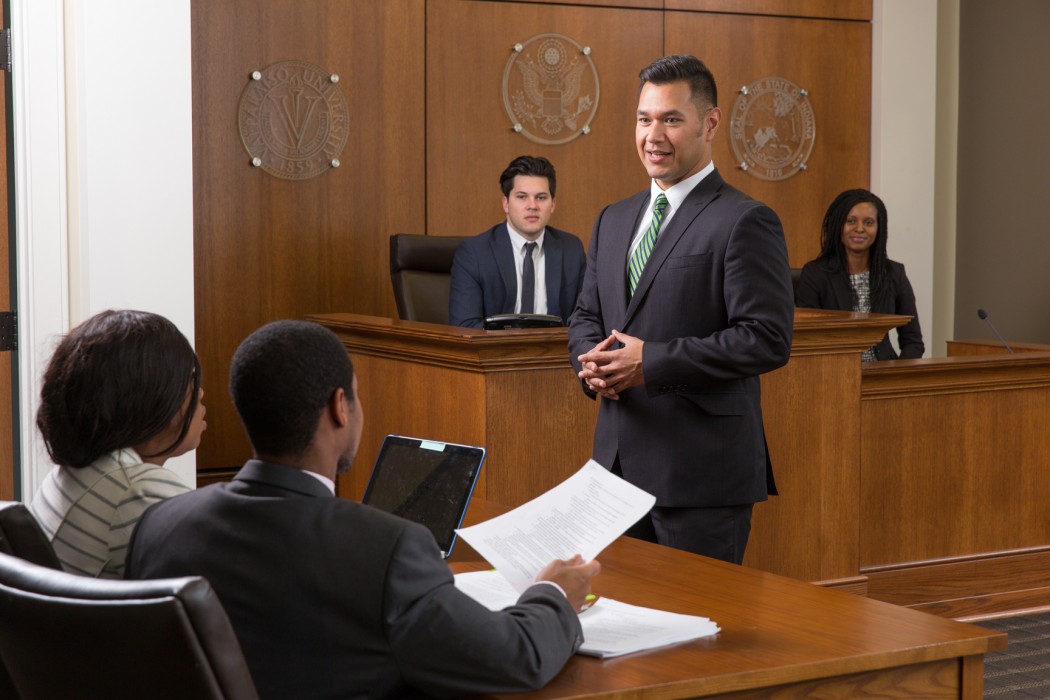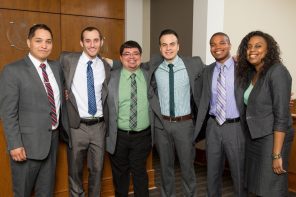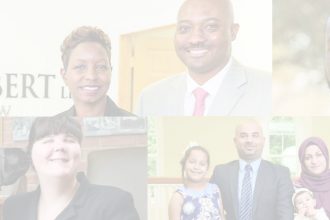Every year at Valparaiso University Law School, an ambitious team of third-year (3L) law students transforms into accomplished oral advocacy mentors, while a new group of second-year (2L) students joins the team. “It’s fun to watch arriving 2Ls really get their first experience with Moot Court arguments and International Moot Court arguments in particular,” says faculty advisor David Cleveland.
In this student-run organization, Cleveland notes, upper-level students organize and run an intra-school International Moot Court competition to prepare team members for ramping up to the international competition circuit. Remarking on the dedicated spirit of student leaders, Cleveland adds,
The 3L students take their roles as administrators, mentors, and teachers very seriously. The students do a great job of setting deadlines and prepping what needs to come next.
INTRA-SCHOOL COMPETITION
Recalling the 2014-2015 season, Cleveland says, “The upper level students created the problem and mentored the new students who were just joining in the spring. The new students then researched the issue, argued the case, wrote briefs, wrote memorials—the international form of briefs—and argued before a panel of professors at the start of the fall semester.
“That case was called The Case Concerning Operation: Provide Shelter. It took place before a simulated International Court of Justice, which is the court arm of the U.N. It had to do with the use of military intervention for humanitarian aid and also issues surrounding activities of troops on the ground of other nationalities, as well as issues of trial in absentia. It was an interesting problem drawn from other problems the students had read.”
Cleveland believes the intra-school competition experience is a great introduction for new team members. As students begin examining international law sources, he says, “They learn about sources of law that go beyond the statutes and case laws they are used to in domestic law, and they get mentors throughout the summer for that. The individual one-on-one mentorship with an experienced International Moot Court student is very helpful.”
The co-curricular component fortifies students’ preparation. In the fall, students take a three-credit public international law class that gives them the foundations of the doctrine of international law as well as a one credit class called Appellate Advocacy: International Moot Court, which is a persuasive argument and writing class. From there, explains Cleveland, students perform the intra-school in the fall, the final intra-school argument. To advance to the final, they must argue through three rounds. The final argument takes place before a panel of three judges, or local judges, or law professors.
Finally, students are placed on teams with student coaches, and they begin preparing for inter-school competitions. Judicial participants were Professor D.A. Jeremy Telman, LaPorte County Judge Richard Stalbrink, Professor Robert H. Knowles, and Attorney Marina Takagi. The Best Oralist award went to Marcya Burden, and the Best Memorial Award went to Gurhan Heinert.
As national and international competitions approach, team members practice their arguments up to five times per week, with the support of Professor Ryan Deutmeyer (‘14 J.D.), an adjunct faculty alumnus of the International Moot Court, and Professor Cleveland, the faculty advisor. “It’s a pretty intense obligation,” Cleveland notes, and 2015-2016 President Osbaldo Santiago agrees: “It’s all about practice, practice, practice. I have never been involved in an organization that requires so much time.” Santiago cites many team weekends consumed with reading, studying, and endless work applying international theories and norms. With that said, though, he adds,
The payoff is amazing. You really get a feeling of what it will be like to prepare for appellate-style cases.
 HUMANITARIAN EFFORTS
HUMANITARIAN EFFORTS
During the 2014-2015 year, Santiago says his focus turned intensely to humanitarian efforts, as the team focused on complex international legal issues involving political upheaval, such as the Ukrainian-Russian conflict, as well as the question of a nation’s legal responsibility for the actions of rebels. At the Susan J. Ferrell Intercultural Human Rights Moot Court competition, which took place in Miami Gardens, Florida January 30–February 1, 2015, participants examined violence in the Middle East and the legality of using YouTube to broadcast messages that would spur further violence.
The issues piqued Santiago’s interest in globally emerging legal needs around international humanitarian concerns, such as political upheaval, asylum, and protection of rights. He is proud of the team’s performance at the Farrell event: “We came in third for best overall team, and the memorial we wrote came in fourth overall. We were up against seven other prestigious teams from all over the world. To do as well as we did speaks highly of our writing courses at Valparaiso University Law School and our team’s extraordinary preparation.”
Santiago notes that social media raises particularly crucial legal issues. “The reason for that is that when governments and states start regulating speech—they start infringing on the basic liberties of individuals. Social media is a new platform where people are going to speak, so the forum of where the speech is being made is over the Internet, and some of it isn’t regulated. Some of it is. The social media companies have their own policies, too. We’re starting to see governments interject themselves into regulating social media. There are also international treaties that come into play, much like our own Constitution and Bill of Rights, that give people the right of freedom of speech. The U.N. Charter and the International Covenant of Civil and Political Rights would be examples. These scenarios open up a whole can of worms,” he explains.
We all have basic rights that need to be not only respected—but protected.
HONING SKILLS THROUGH COMPETITION
Santiago may have found his courtroom sea legs through his International Moot Court experiences. “You find your comfort zone when you’re in front of judges. It can be really nerve-wracking when they throw questions at you that you don’t know the answer to because one—you are really scared being up there, and two—no matter how much you prepare for something, you don’t know what questions are going to be asked.” How does one tackle these challenges? “One of the things I’ve been told is, remember, it’s just a conversation with the court. You are talking to the judges as if you were talking to anyone else. This was advice to us from one of the professors: A tough question from a judge is a good thing because it shows that the judges are interested in what you have to say. I’ve grown to appreciate that and that advice has really helped my nerves,” says Santiago.
Also active in the Latino Law Students Association and the Student Bar Association, Santiago has nothing but praise for the strength and passion of the team, the coaches, and the professors. Looking ahead to the 2015-2016 year, he predicts, “We’re going to do really well!”
More Competitions
MONROE E. PRICE MEDIA LAW MOOT COURT COMPETITION
Benjamin N. Cardozo School of Law in New York City (January 28–February 1, 2015)
This year’s problem focused on the impact of social media in the differences between two clashing religions and a state’s attempt to take matters into its own hands and control social media by enacting its own laws governing media in its jurisdiction. Do such laws violate international human rights law? The team, led by 3L Coach Julie Johnson, wrote Appellate Memorials on the issues. Shannon Kendrick and Michael Sanchez, both 2Ls, wrote on behalf of Deri Kutik, a young man who uploaded a religiously charged video on a video-sharing website. Meanwhile, 2Ls Natasha Ram and Maison Haines argued in the alternative for their client, the Republic of Lydina, stating that the specific law being challenged is valid under the International Covenant on Civil and Political Rights, among others.
16TH ANNUAL D.M. HARISH MEMORIAL GOVERNMENT LAW
College International Moot Court Competition, Mumbai, India (February 9–15, 2015)
This year’s competition dealt with issues of humanitarian intervention, cyberterrorism, and international investment law between the fictional countries of Antagonia and Ploonkistan. Members Delicia Zayas and Jarryd Morton (both 2Ls) competed in the Oral Rounds at the competition, arguing four separate and current issues of international law. Facing several extremely competitive teams from all over the world, the Valparaiso University Law School team placed 16th place overall. Coach and Researcher Victoria Feddeler (3L) received 13th place in the Researchers Test. The team spent time with other law schools from around the world and have made invaluable contacts as a result of this competition. All can be proud of the team’s achievements, making it to the Octo-Round, and competing against 26 other teams.
PHILIP C. JESSUP COMPETITION
University of Denver Sturm School of Law (February 13–16, 2015)
This was the first year that Valparaiso University Law School competed in the Denver Regional. Competitors Jacquelyn Altpeter, Cassandra Neal, Roy Johnson (all 2Ls), and 3L competitor Connor Nolan prepared Appellate Memorials on The Case Concerning the Secession and Annexation of East Agnostica. This competition case presented questions of treaty interpretation, and how treaties apply under changed circumstances. It also presented questions of the propriety of countermeasures and procedural as well as substantive issues raised by the secession of a province from one country and its annexation by another. The team then prepared arguments based on their memorials, with the help of 3L Coaches Naila Alam and Tyler Mesman. The Valparaiso University Law School team competed against teams throughout the United States, and Cassandra Neal placed 15th overall in the individual oralist rankings.





